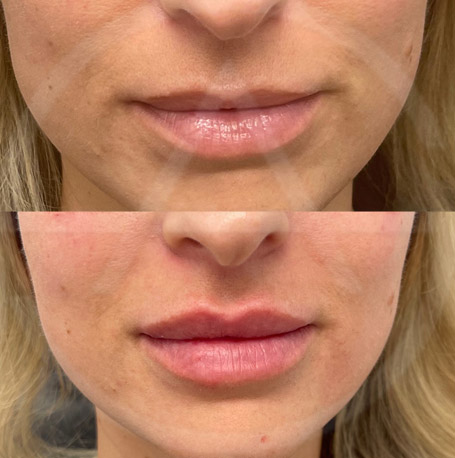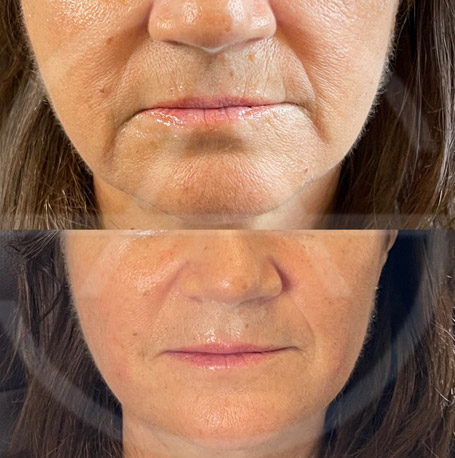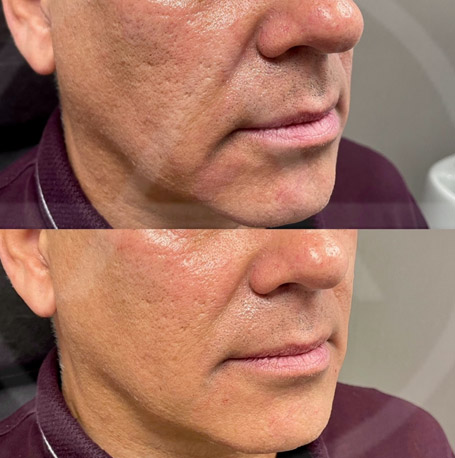
Dermal Fillers
Table of ContentsToggle Table of ContentToggle
What Are Dermal Fillers?
Dermal fillers are injectable substances used in cosmetic and medical procedures to add volume, reduce wrinkles, enhance facial contour, and give a more balanced, rejuvenated appearance. These fillers are typically made of various materials and work by filling in lines, wrinkles, and areas of volume loss, providing a more youthful and smoother appearance to the skin. Dermal fillers can be used for various purposes, including:
- Smoothing Wrinkles: Fillers can be injected into fine lines and wrinkles to plump the skin and reduce their appearance.
- Restoring Volume: They are commonly used to replace lost volume in areas like the cheeks, temples, lips, around the eyes, and more.
- Contouring Features: Fillers can be used to reshape the nose, chin, and jawline, etc.
- Filling Scars: They can help improve the appearance of acne scars or other depressions in the skin.
- Non-Surgical Facelift: Dermal fillers can provide a non-surgical facelift by lifting and tightening the skin.
What Are the Different Types of Dermal Fillers?
There are several different types of dermal fillers, each with unique properties and purposes. The choice of filler depends on the specific aesthetic or medical goals of the patient. They can be further broken down into hyaluronic acid-based fillers and biostimulators. The common types of dermal fillers used by Dr. Sarah Avila are:
- Hyaluronic Acid (HA) Fillers: Hyaluronic acid is a naturally occurring substance in the body that helps maintain skin hydration and volume. HA fillers are popular for their versatility, temporary results, and ability to be reversed or dissolved. They can be used to smooth wrinkles, add volume, and enhance lips. Common brands include Restylane, Juvederm, and RHA.
- Calcium Hydroxylapatite Fillers: These are biostimulator fillers that contain calcium microspheres suspended in a gel. They provide both immediate volume and stimulate collagen production over time. They are often used for deep wrinkles and volume loss. Radiesse is a well-known calcium hydroxylapatite filler.
- Poly-L-Lactic Acid Fillers: These are biostimulator fillers that stimulate collagen production, leading to gradual, natural-looking results. They are used for adding volume and addressing facial sagging. Sculptra is a popular brand of poly-L-lactic acid filler.
- Autologous Fat Injections: In this procedure, a patient’s own fat is harvested through liposuction, processed, and then injected into areas that need volume or contour enhancement. Unlike other fillers, fat injections are permanent.
Each type of filler has specific characteristics, including how long the results last, the depth of placement, and the areas it is best suited for. Dr. Sarah Avila will help you decide which one is best for your goals and concerns during consultation.
Dr. Avila’s Philosophy on Dermal Fillers
Dr. Avila prides herself in notable yet subtle, natural results. Every treatment plan is customized to meet individual needs as no two faces are the same. With Dr. Avila, you will still feel like yourself, just more refreshed.
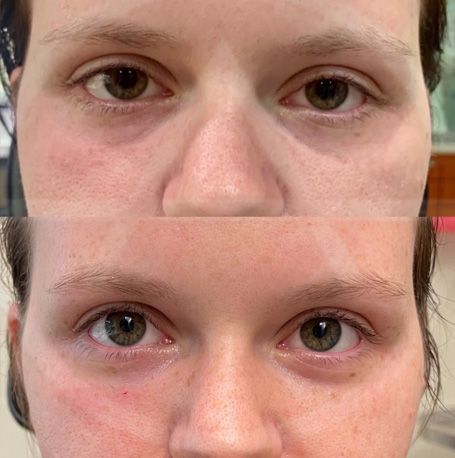
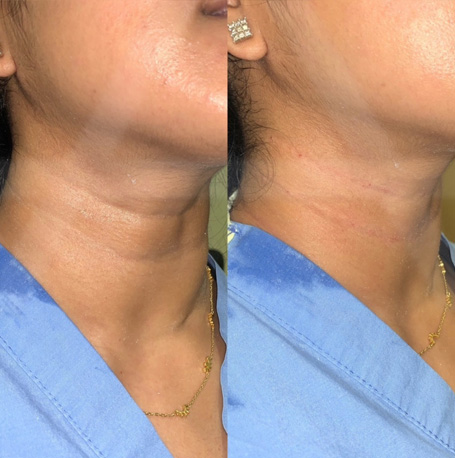
Where Are Dermal Fillers Used?

- Tear Troughs: To reduce the appearance of hollows or dark circles under the eyes.
- Nasolabial Folds: To fill and smooth the lines that run from the sides of the nose to the corners of the mouth.
- Marionette Lines or Jowls: To soften and lift the lines extending from the corners of the mouth downward to the jawline.
- Lips: To enhance volume, shape, and definition. They can also treat lines around the mouth (perioral lines).
- Cheeks: To add volume and contour to the cheeks, restoring a more youthful appearance.
- Temples: To add volume and improve the appearance of hollow or sunken temples.
- Jawline: To define and reshape the jawline, providing a more youthful and sculpted look.
- Chin: To enhance the projection and shape of the chin.
- Nose (Non-Surgical Rhinoplasty): To reshape the nose, providing a non-surgical alternative to a traditional rhinoplasty.
- Hands: To improve the appearance of aging hands by adding volume and reducing the visibility of veins and tendons.
- Buttocks: To add volume and provide a non-surgical natural butt lift.
The choice of where to use dermal fillers depends on the patient’s specific concerns and goals, as well as the expertise of the healthcare professional performing the procedure. Dermal fillers are a versatile tool for addressing a wide range of aesthetic issues and are often customized to suit individual needs.
When Will I See Results from My Filler Injection?
The time it takes to see results from filler injections can vary depending on the type of filler used and individual factors. In general, you may notice immediate improvements, but the full and final results may take some time to develop. Here is a general timeline:
- Immediate Improvement: With some dermal fillers, you may see an immediate improvement in volume and contour as the filler is injected into the target area. This instant change can be noticeable right after the procedure.
- Initial Swelling: It’s common to experience some swelling and redness at the injection site, which can affect your initial appearance. This swelling is typically temporary and may last a few days.
- Subtle Changes Over Days to Weeks: Over the course of several days to weeks, you may notice subtle changes as the filler settles and integrates with your tissues. During this time, the filler may continue to plump and smooth the treated area.
- Full Results (2-6 Weeks): The complete results of your filler treatment are typically visible within 2 to 6 weeks. This is when any initial swelling and bruising have subsided, and the filler has fully integrated with your skin.
Keep in mind that individual experiences can vary, and the timeline for seeing results may differ depending on the type of filler used, the area treated, and your body’s response.
How Long Do Dermal Fillers Last?
The duration of dermal fillers’ results can vary depending on several factors, including the type of filler used, the area treated, individual metabolism, and the amount of filler injected. In general, the longevity of dermal fillers’ effects falls into the following ranges:
- Hyaluronic Acid (HA) Fillers: HA fillers, such as those in the Juvederm and Restylane families, typically last from 6 to 18 months. Lip fillers tend to break down faster than fillers used in other areas.
- Calcium Hydroxylapatite Fillers: Fillers like Radiesse typically last around 12 to 18 months, and they may stimulate collagen production for longer-lasting effects.
- Poly-L-Lactic Acid Fillers: Sculptra can last up to 2 years or more, as it stimulates collagen production, resulting in gradual and natural-looking results.
It’s important to keep in mind that individual experiences can vary. Some people may metabolize fillers more quickly, while others may enjoy longer-lasting results. Maintenance treatments are often necessary to sustain the desired effects, and the frequency of touch-up appointments can vary from person to person.
How Much Do Dermal Fillers Cost?
The cost of dermal fillers can vary depending on the type of filler, the area treated, the number of syringes needed to address your concerns and the expertise of the surgeon. Dr. Sarah Avila is an oculofacial surgeon with extensive knowledge in non-surgical rejuvenation using injectable filler. To get an accurate cost estimate for your specific needs, it’s best to schedule a consultation.
Cosmetic Filler Procedure Overview
Cosmetic fillers with Dr. Sarah Avila begin with a consultation to discuss your goals and expectations. Dr. Avila will then assess your facial anatomy and determine the appropriate type and amount of filler needed. The treated area will be cleansed and disinfected, and a topical numbing cream is applied to minimize discomfort. As a board-certified oculofacial surgeon, Dr. Avila may also administer nerve blocks for maximal comfort. Using a fine needle or cannula, Dr. Avila carefully injects the filler into the targeted areas. You will be given specific aftercare instructions, such as avoiding strenuous exercise, not touching the treated area, and using cold packs to reduce swelling. After two weeks, you will return to assess results and determine if any touch-ups are needed.

Sarah Avila, MD
Specialization: Eyelid Surgery & Aesthetics
Dr. Sarah Avila is an oculofacial plastic surgeon in Miami, Florida. After completing medical school, Dr. Avila completed a residency in ophthalmology at the Mount Sinai Hospital, followed by a highly competitive two-year ASOPRS-accredited fellowship in reconstructive and cosmetic oculofacial surgery at Emory University. During this fellowship, Dr. Avila focused on plastic surgery related to the eyelids, brows, lacrimal duct system, orbit, and face.


